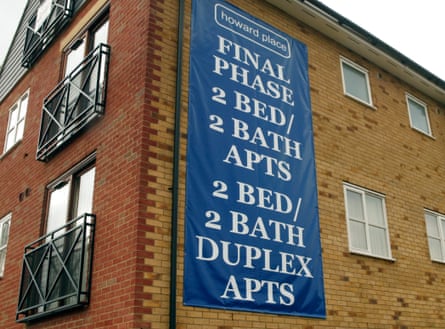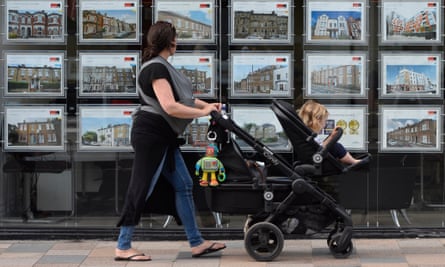It was launched with great fanfare in 2013 and has been credited with helping many thousands of young people and families on to the housing ladder – but it has also swallowed up billions of pounds of taxpayers’ cash and been accused of pushing up property prices and boosting housebuilders’ profits.
The government’s help-to-buy scheme has taken various forms over the years and is finally set to end in March 2023.
However, the key deadline is a lot sooner than that: first-time buyers who want to take advantage of it have only got a little over three months left to reserve a property and apply.
The current version of the scheme offers a government loan – AKA an equity loan – to enable people to buy a newly built property with a deposit of only 5%
The 31 October deadline for applications only emerged at the end of May and is two months earlier than had been expected.
A survey published this week found that 73% of first-time buyers were unaware this is the last date you can reserve your home and apply. Some will have assumed they had until early next year.
During recent weeks, adverts from developers with headlines such as “Your last chance to buy”, “Buy! (Before it’s goodbye)” and “Last remaining apartments available …” have been appearing in newspapers.
But it is important for those thinking about signing up to fully consider whether help to buy is right for them and make sure they are aware of all the financial implications.
 View image in fullscreenThe developer Fairview New Homes says properties sold via help to buy must have reached ‘practical completion’ by 31 December this year. Photograph: Graham Turner/The Guardian
View image in fullscreenThe developer Fairview New Homes says properties sold via help to buy must have reached ‘practical completion’ by 31 December this year. Photograph: Graham Turner/The Guardian
With the deadline looming, “you might be tempted to race for the door before it closes. However, if you’re in too much of a rush to get to grips with what you’re getting into, you could be in for a nasty surprise in five years’ time,” says Sarah Coles, a senior personal finance analyst at the investment firm Hargreaves Lansdown.
The developer Fairview New Homes says properties sold via the scheme must have reached “practical completion” (that is, be fully built and ready to live in) by 31 December this year, and adds that is why there is “limited availability” of help-to-buy properties remaining across the country.
Help to buy was launched by the then chancellor, George Osborne, in 2013 to kickstart the housing market after the financial crisis. Initially there were two parts, a mortgage guarantee scheme and a loans scheme, and they were available to all homebuyers.
The basics
In England, the current help-to-buy: equity loan scheme opened for applications in December 2020. The government lends a buyer between 5% and 20% of the full purchase price of a newly built home, or up to 40% in London. The buyer needs to stump up a deposit of at least 5% of the property’s value.
The loan from the government means you will need a smaller mortgage, which will be easier to afford. In London, those getting the full equity loan only need a mortgage of 55%.
Eligibility
You need to be 18 or over and a first-time buyer. You can apply on your own or with other people, although all applicants must meet the eligibility rules.
The property has to be sold by a help-to-buy-registered homebuilder.
There are also price caps on what you can buy. In London the scheme can be used to buy a home costing up to £600,000, and the caps vary across England – from £186,100 in the north-east to £437,600 in the south-east.
 View image in fullscreenTo be eligible for the scheme, the property has to be sold by a help-to-buy-registered homebuilder. Photograph: Geoffrey Swaine/Rex/Shutterstock
View image in fullscreenTo be eligible for the scheme, the property has to be sold by a help-to-buy-registered homebuilder. Photograph: Geoffrey Swaine/Rex/Shutterstock
How the equity loan works
The government loans are interest-free for the first five years (there’s a £1 monthly management fee).
After that, you start to pay interest. In year six you pay a monthly interest fee of 1.75% of the equity loan, and this will then rise annually by the consumer prices index (CPI) inflation measure plus 2%. (Under the previous version of the scheme it went up by the retail prices index, or RPI, plus 1%.)
Remember that the equity loan payments are interest-only, so you are not reducing the amount you owe
With inflation soaring at the moment – it is currently 9.4% – that may alarm some potential buyers.
Remember that the equity loan payments are interest-only, so you are not reducing the amount you owe.
However, the good news is that you can repay all or part of your equity loan at any time. It must be settled when the home is sold or the mortgage is paid off.
If you are able to pay off the equity loan before the interest starts kicking in, that is the ideal scenario.
Crucially, the amount you pay back is worked out as a percentage of the property’s market value at the time you choose to repay. So if the value of your home rises, so does the amount you owe on your equity loan. Equally, if the value falls, what you owe falls, too.
What the experts say
Coles says it is impossible to accurately predict what is going to happen over the next five years, “so you need to understand all the potential scenarios – and how expensive they could be”.
Nick Mendes at the mortgage broker John Charcol says the scheme’s pluses include giving first-timers access to cheaper mortgage rates, as it means they don’t have to take out a 95% deal. Negatives include the fact that buyers will be limited to certain properties and locations, as not all new-builds are part of the scheme.
An example
Let’s say you buy a house worth £250,000, with a £12,500 deposit, a £50,000 government loan and a £187,500 mortgage.
If house prices rise an average of 5% a year for the next five years, your house would be worth about £319,000. Let’s say that at that point you decide to remortgage and repay the equity loan. However, you won’t pay back £50,000. You borrowed 20% of the purchase price, but you will repay 20% of the value of the property now, which is £63,800. “The loan has cost you £13,800 over five years. If house prices rise faster, this cost will be higher,” Coles says.
 View image in fullscreenUnless you have saved enough money, you may not have enough equity to enable you to remortgage. Photograph: Joe Giddens/PA
View image in fullscreenUnless you have saved enough money, you may not have enough equity to enable you to remortgage. Photograph: Joe Giddens/PA
However, if prices don’t rise, you will be left with a different issue. Unless you have saved enough money, you may not have enough equity to enable you to remortgage, so you could end up paying the interest fees instead. In the first year this will be 1.75% of the outstanding amount: £875.
But for those signing up to the current version of the scheme, this will then rise each year by CPI plus 2%. Right now CPI is 9.4%, “so if inflation remains high, this annual fee will rise significantly, making it even more difficult for you to save enough of a deposit to remortgage,” Coles says.
She adds that it might be difficult for new buyers to imagine a time when house prices don’t rise, but there have been plenty of them. “Even if prices do rise, there are no guarantees that the value of your home will increase, particularly because it will lose a big chunk of its new-build premium. This premium has soared in recent years, so you might have paid 30% more just for the privilege of being first in the property.”
Other countries within the UK
In Wales there is a help-to-buy scheme offering shared equity loans of up to 20% to buyers of new-build homes. This is due to run until March 2023. The help-to-buy (Scotland) schemes are now closed, although the Lift (low-cost initiative for first-time buyers) scheme continues to be available.
‘Have a vision and stay focused on the plan’
The management consultant Busola Ilesanmi bought her first home using help to buy in December last year.
“After 10 long years of paying so much money towards renting spaces shared with others, it was a relief to finally be able to buy my own home after starting my career and six years of savvy saving,” she says.
Ilesanmi bought a £324,000 one-bed flat with a balcony and parking space at the housebuilder Fairview New Homes’s NewHayes development in Hayes, west London. She had been looking for somewhere that was an easy commute to work and close to her existing social network.
Using help to buy meant she was able to put down a 5% deposit (£17,100) and borrow 40% from the government. This has left her with monthly mortgage repayments of £863 for the first five years of her 25-year mortgage.
 View image in fullscreenBusola Ilesanmi bought a £324,000 one-bed flat using help to buy. Photograph: Busola Ilesanmi
View image in fullscreenBusola Ilesanmi bought a £324,000 one-bed flat using help to buy. Photograph: Busola Ilesanmi
Ilesanmi came to the UK from Nigeria in 2010 to do a master’s degree in financial management. In 2014 she moved from Scotland to England, and a year later she started saving to get on to the property ladder.
“My strategy around finance is fairly strict: 50% of my income goes on bills and living expenses, 30% on entertainment and lifestyle, and 20% on savings and investment. This approach meant I could reach my saving goals in a realistic timeframe while continuing to rent and enjoy life’s small luxuries,” she says.
She adds that because of the area’s good transport links, “I was happy being in zone 5 in order to get a more spacious flat with outside space and a car park … It offers great access to Heathrow, my place of work and central London. I was also really excited by the Elizabeth line coming to Hayes. It definitely made the area more appealing.”
In terms of her tips for others wanting to get on to the property ladder, she says: “Make sure you have a vision and stay focused on the plan … It’s also really important to manage your credit score so you’re able to get your mortgage application approved.”
Other homebuyer schemes
First Homes
Under this government initiative, first-time buyers in England can apply for a discount of up to 50% on a newly built home.
First Homes is targeted at first-time buyers in the area where the homes are built. Properties are discounted by at least 30% compared with market prices, and in some areas the discount could be as high as 50%.
The maximum household income is £80,000, or £90,000 in London. There are also price caps: after the discount has been applied, the purchaser cannot be required to pay more than £250,000, or £420,000 in London.
 First Homes is targeted at first-time buyers in the area where the homes are built. Photograph: Chris Radburn/PA
First Homes is targeted at first-time buyers in the area where the homes are built. Photograph: Chris Radburn/PA
However, councils can have their own requirements such as prioritising key workers or local people, and may set lower income and price caps.
Crucially, the discount will be passed on with the sale of the property to future first-time buyers. You need to put down a deposit (a minimum of 5% of the discounted purchase price).
Shared ownership
You buy a share of a new-build or resale property – between 10% and 75% – and pay rent on the share that you do not own.
There may well also be ground rent and service charges to pay, although the government has introduced a 10-year period during which your housing provider will be required to support you with the cost of essential maintenance and repairs.
Because the buyer only needs a mortgage for the share they are purchasing, the deposit needed is usually a lot smaller than for a standard home purchase. The rent is less than the rate charged on the open market.
You have the option to buy further shares – up to 100% ownership in most instances – if you wish. This is known as staircasing.
 View image in fullscreenThe buyer only needs a mortgage for the share they are purchasing. Photograph: Hannah McKay/EPA-EFE
View image in fullscreenThe buyer only needs a mortgage for the share they are purchasing. Photograph: Hannah McKay/EPA-EFE
To be eligible, you need to have an annual household income of less than £80,000 – or less than £90,000 in London. Some housing associations etc have their own terms regarding who is prioritised and affordability.
All shared-ownership homes (houses and flats) are leasehold.
This information relates to England. There are different rules for shared ownership in Scotland, Wales and Northern Ireland.
The mortgage guarantee scheme
Launched last year, this official scheme aimed to increase the availability of 95% mortgages, and – claims the government – has succeeded in doing so.
It is open to first-time buyers and existing homeowners who are looking to move and require a 95% LTV repayment mortgage
It works by giving banks and building societies the chance to buy a guarantee on the riskiest portion of the mortgage – the bit between 80% and 95% loan-to-value (LTV). The government covers that chunk of the lender’s losses if a home has to be repossessed, for example, after a property crash.
It is available from participating lenders across the UK on properties costing £600,000 or less, where a borrower has a deposit of 5%.
It is open to first-time buyers and existing homeowners who are looking to move and require a 95% LTV repayment mortgage.
However, the scheme is only due to run until 31 December 2022.





Leave a Reply
You must be logged in to post a comment.